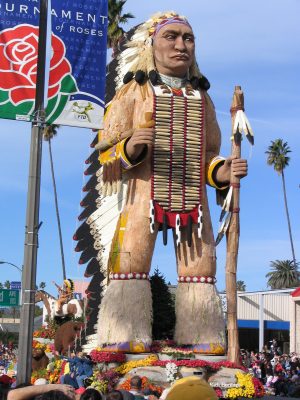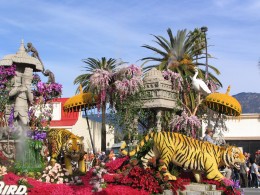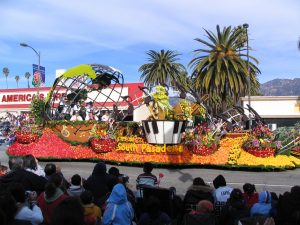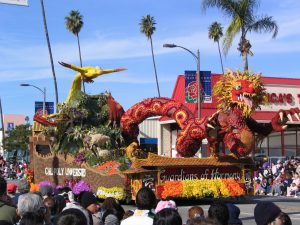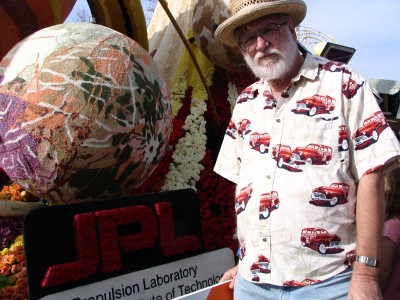The Tournament of Roses is the largest consumer of flowers in the world. Somewhere between 500,000 and 1,000,000 people line the parade route, depending on who you believe. It stretches 5½ miles from beginning to end, and takes about two hours to pass any one spot. The mind boggles …
Yes, I know, we’re still a few miles away from Pasadena on our bifurcated Route 66 walk, but who said we have to be chronological, or consistent? We plan to take several detours, a few miles off the main road, to visit sites of interest like Heritage Square, The Huntington Library and Gardens (as soon as they open their new Chinese Garden, this February), Cal Tech, and maybe Santa Anita. And the parade does go down Colorado Boulevard, and that is a part of Route 66, undisputed, no two ways about it. So who cares that we had to skip ahead to watch it?
We went for the first time last year, after a friend (Thank you, Jon!) informed us that it is possible to see it, free, if you get there a little early and find a place nearer the end than the beginning. The crowds are incredible, of course, and people always seem to be moving so there’s a certain amount of jostling in the back of the crowd, unless you’re like one lady we talked to in the front row, who had been then since Sunday, with her comfy chair and blankets and family. (This was Tuesday, when we talked to her.) There are barbecues, and tents, and RVs parked all up and down the route. But I brought a folding chair to rest my knees when nothing was passing by, and we brought a folding stepladder for Lee, which got her up high enough that she could take pictures over the heads of the crowd. She took 527 of them …
December 30, 2007 – Construction
But our story doesn’t really begin there, it begins on Sunday, probably just about the time that determined parade-goer was setting up her campsite there on the curb. For $5 you can go out to the Rose Bowl and two other sites before the parade and see the work being done on the floats. This is fascinating stuff. There is a big tent south of the Rose Bowl, and a permanent building not far away from it. Inside, hundreds and hundreds of people are hard at work attaching millions and millions of flowers to the floats. You can see what they look like before it’s all done.
The rules of the parade are pretty simple, it seems: you can make it as big and elaborate as you want, but every square inch of surface must be covered in flowers, petals, seeds, bark, or other vegetable matter. They go so far as to paste leaves on the plastic seats people will be sitting on. Also, the roofs of these assembly buildings are, in many cases, lower than the finished float will be. That means that they must be collapsible to even get out of the place. I wouldn’t be surprised if the route to the assembly area might have a few low places, too, so you have to be ready to tow your finished product there and then set it up. This year, the tallest float was an Indian chief, and we have pictures of what it looked like both before and after he was hoisted to his feet. It’s quite an undertaking. And when I saw him in the parade, I was reminded that his entire front had to be decorated by people lying on their backs, reaching up like Michelangelo painting the Sistine Chapel.
Most of these floats are designed and built by four companies (Fiesta Parade Floats, Phoenix Decorating Company, Festival Artists, & Studio Concepts, Inc.)—though there were six this year that were “self-built,” and they were not at all shabby, such as the long, long dragon on the Cal Poly float. These companies do the structural work, and then paint the areas where different colored flowers are to be glued. Then the army of flower pasters move in at the last minute—just after Christmas, actually—to do the grunt work with the glue and the flowers. Can’t have wilted blossoms; in fact, many of the stems of the more delicate varieties are in little individual tubes of water to keep them fresh. These volunteers are devoted to their work, and all the ones we talked to were very happy to be there. They viewed it as a privilege to work on these incredible fancies.
Then the floats are parked at the end of the parade route, where 150,000 people will view them the next day … and then they are torn apart. And guess what? The day after that, they start planning and building the floats for next year!
We visited the tent and the building at the Rose Bowl, like we did last year, and this time we also visited the building just off of Fair Oaks Boulevard. If you’re planning to come to Pasadena some New Year’s Day and want to see some float decorating, this is what I’d recommend. That building had almost no crowd at all, whereas at the Rose Bowl there was a 15-minute line to get in. There is a fourth decorating site, but it’s way, way, way out in Duarte, about 10 miles away from the beginning of the parade. That seems odd to me, and I wonder what it must be like on New Year’s Eve, in the dead of night, when these behemoths have to be trundled through the city streets to be there in time for the parade to begin at 8 AM. I’d really like to see that! Making note of the floats we saw in the places we visited, and the ones that were new to us, I’d say that well over 1/3 of the floats, and some of the bigger ones, at that, were built in that Duarte facility. Next year, we’ll be sure to take a look at that one.
There was RV parking at the Rose Bowl … for $400 a night, plus $30 for a tow vehicle! There were plenty of takers. I guess a lot of people spend a lot more on hotel rooms and tickets to see the parade and/or ball game. (You mean a football game happens on the same day as the parade? Fancy that!)
January 1, 2008 – Presentation
We found a spot on Greenwood Street at about 8 AM, when the parade was just starting way back west, on Orange Grove Boulevard, back where the expensive seats are. (We’re considering buying some bleacher seats next year.) It was a jolly crowd. All the kids seemed to have cans of silly string, an almost endless supply, as they were still spraying each other an hour later. At the other parade we used to attend regularly, the Portland Rose Festival Grand Floral Parade (which bills itself as the second-largest floral parade in the country, and I’m sorry, Portland, I love you, but it’s a distant second), everybody seemed to have those thick sticks of sidewalk chalk, and by the time the parade appeared the whole street was pretty much covered with pictures and scrawls and hopscotch layouts. None of that here that I could see. I wonder why? Different traditions, I guess. Both here and in Portland: a lot of people with those annoying plastic horns, tooting away. Unique to Pasadena: The smell of frying franks as a lot of those little LA stands selling bacon-wrapped dogs with fried onions and peppers and a jalapeno on the side were doing good business.
Lee’s pictures will speak better than any words I can write here about the grandeur and awesomeness of the floats. There were 47 of them (though the 6 boat-themed floats of the Port of Los Angeles counted as just one unit), and they were all damn impressive, though of course some were more impressive than others.
As an old bandsman (French horn and baritone horn), I was of course very interested in the bands. There were 22 of them, and they are the absolute best to be found from all over the country, as well as units from Zurich (a police band!), Japan, El Salvador, and Canada. The Marine Corps Band was there, and the Salvation Army. The All-Kamehameha Band from Hawaii was probably the most exotic looking, and the USC Trojan Band was probably the crowd favorite. They have a distinctive, in-your-face way of marching when they’re playing the school fight song. But my sentimental favorite was the Golden Dragon Band from Nacogdoches (pronounced nack-a-DO-chiz), Texas, which is about two hours north of my home town of Nederland, home of the Golden Pride of the Golden Triangle, the NHS band. We were 96 strong, 8 by 12 when marching, and the Dragons looked to be about twice that size. They were very good, too. This was their first time at the Tournament of Roses. By the time they got to us they’d already marched about 4 miles, and I know from experience they were pretty pooped, but they were playing their hearts out: “Hands Across the Sea,” by John Philip Sousa, a march we played many times on the football field. They had the unenviable position of marching right behind the Marine Corp Band (with two floats intervening), which is probably the best marching unit in America, but they did well.
The great majority of bands were playing something when they marched past us, which simply means they were playing a lot, and let me tell you, for a brass player that means your lips feel they’re about to burst. But it’s appreciated. And they’re young. A march like that would just about kill me, these days, and I got no lip at all.
Then there were the equestrian units, 18 of them, and once more, these were the cream of the crop, to the point you sometimes wondered how a single horse could carry that amount of silver, plus a cowgirl or a Mexican roper. Many of these units have a long Tournament of Roses history. I liked the Classic Curly Riders, who were all on these super-weird horses with long, curly hair, American Bashkir Curly horses, all descended from a single mutation 100 years ago. Other than that, though, I feel that equestrian units are mostly good for fouling the parade route with horse poop, which the bands then have to march through.
This parade always moves like clockwork, seldom stopping, and big gaps are almost unheard of, unlike many parades we’ve been to, when gaps sometimes got as wide as 20 minutes. I was never able to sit down for more than about three minutes at a time. They have an entire fleet of tow trucks stationed on every side street, literally one for every float, and when one breaks down (three of them did, this year) they hook that sucker up in about 60 seconds and move right along. At the end of the parade these massive tow trucks, the sort they use for towing broke-down semis and buses, all drove by us, blasting their horns.
A perfect parade day, weatherwise and in every other way.
January 2, 2008 – Valediction
The afternoon of the parade and the day after, starting at 7AM, the floats are all on display at the end of the route, along Sierra Madre Boulevard and Washington Boulevard in upper Pasadena, in the Eaton Wash. Parked end to end, they cover about a mile of city street. They were expecting 150,000 visitors today. That’s half again as many people as the Rose Bowl seats … Some people think the Tournament of Roses is about a football game, but I tell you, friends, it’s about the parade, the game is just a sideshow …
They said there was no parking within about a mile of the display area, but there were shuttle buses running continuously from three locations. We chose the Rose Bowl, parked, and paid our $7 admission and $3 bus tickets, and soon were rattling up a hill in a big yellow school bus. I don’t think either of us had ridden on a school bus since high school. They are still too cramped for my knees, but the seats were more comfortable. In addition to a first aid kit, there was something up by the driver called a “Body Fluid Cleanup Kit.” What was that all about? I decided not to ask just which of the many body fluids they were talking about, as not many of them are pleasant to contemplate. I spent uncounted hours in buses like these, traveling with the band to different schools in East Texas, often getting back around sunrise. Me and my girlfriend always signed up for the back seat, where we would cuddle and engage in some heavy petting. Ah, precious memories! Second base!
We moved at pretty good speed along Washington Boulevard, an area we had not visited before. Some of it was more rundown than you expect to see in Pasadena, but as we approached the end of the trip it was getting more yuppified, with shops selling fine wines. Not far to the north were the bare hills of the Angeles National Forest … and a damn good thing, too, or you just know those hills would be overrun with McMansions.
I wouldn’t for the world want to slow up the parade, but there is one big disadvantage to having it move so smartly: You don’t get a lot of time to see any one float. You don’t realize just how much they pay attention to the details, or just how imaginative is the use of flowers and fruits and seeds and leaves and bark to achieve the effects they want. Also, some of the floats have a thing they do. This year, it was the Honda float. It looked like nothing more than a great big yellow pickup truck. Not very original, and way too commercial for the day. However, it began to change … and it turned out it was a Transformer, it was turning itself into a spaceship. But it did it rather slowly. The hood flipped through a 180, revealing an astronaut inside, and the whole thing rose up on steam jets, the wheels flipped out … and then it moved on out of our line of sight. Damn! I wanted to see the whole thing!
Not to worry. They had that one and a half dozen others that featured a lot of motion in a special display area (all the other floats were no longer powered). When we got there we were able to see the whole operation, jets sprouting from the back, wings flipping down, and then the whole process reversed until it was just a big pickup again. The crowd applauded. In this area the hatches on the floats were opened, so we were able to see inside the Honda float, where there were great big cylinders of compressed gas, and other arcane stuff. It was quite an engineering project.
You could talk to the drivers of these incredible vehicles. Turns out they can’t see shit when they’re in their tiny little compartments underneath. They’re told when to turn and when to stop and when to go by one of the ubiquitous Rose Parade monitors in their creamy white suits, riding on little Honda motorcycles alongside the floats. The drivers all seem to be veterans, wearing white jumpsuits that sport patches from every float they’ve driven. Yes, folks, they give out patches to all the people who work on the floats, showing the floats themselves, just like NASA gives out for every Shuttle flight!
In this parking area you’re able to get within about three feet of the floats, and appreciate the details. It is just stunning to see how carefully they are put together. Which is why I was glad we’d watched the decorating process. It struck me that there were quicker ways. Much of the surfaces of the some of the objects on the floats were covered in dried petals separated from the flowers, or crushed, and some with materials like rice in different colors, seeds … tiny stuff. I’m sure it would be possible to coat a surface with glue and then spray this stuff on, cover a few square feet in just a minute. But no, that’s not how it’s done at the Tournament of Roses. The volunteers coat a small patch with glue, and then apply the material by hand. These people must be covered in glue at the end of the day. But craftsmanship is its own reward.
Can you tell the difference as the float rolls by you? Frankly, no. But here you can, you can see the love that went into these displays. I remember staring at a star, one of a few dozen, each about two feet across. They were covered with kernels of golden popcorn, and each kernel had been fitted against its neighbor like a piece of mosaic tile … and not only that, but oriented so that the white tip of each kernel faced outward! Or one display that feature postcards, a few feet square, with pictures and addresses and even stamps carefully detailed in multi-colored flower petals.
Both the commonplace and the exotic are employed. We saw pink-tipped white artichokes, and strings of kumquats hanging as fringe from Chinese umbrellas. Elsewhere, such as on a great globe of the world, kumquats, grapes, almonds, limes, lemons, yellow and green lentils, and cranberries had been split in half and glued to different nations on the map. There was a big, comic alligator, and his skin was made of pineapple rinds fitted so cleverly you could hardly see the joins. Pampas grass and wheat became lions’ manes. All the boats of the Port of Los Angeles fleet were throwing up bow waves and trailing wakes of blue and white flowers that looked like water and spray. Way above the Beijing Olympics float were bursts of flowers that looked just like fireworks.
The rose is certainly the dominant flower here, and they are there in their millions, in every color a rose can be, often arranged in carefully crafted spectra from pale to intense, other times just huge, dense beds of them. But there are many others. The daisies were starting to droop, just 24 hours after the parade; you could see the little water flasks they were sitting in. But what amazed me was how many orchids there were. These are not cheap flowers, as you probably know, and there were thousands of them on some floats.
Longest float: Western Asset (whoever that is), with a four-car circus hitch: a life-size locomotive, an animal car, a trapeze car with acrobats performing, and a calliope bringing up the rear.
Most moving: Donate Life. Four hot air balloons with the pictures of people who died and donated organs. Sitting around on the bottom were some of the people whose lives had been saved by these donations.
A personal favorite: The Jet Propulsion Laboratory, with a Mars rover, various space probes, globes of all the planets and moons these probes have visited, and over it all a big Explorer 1, which was launched 50 years ago this January 31st, America’s first satellite.
Least welcome: A float for the Palazzo Resort. Yeah, I know many of the floats are sponsored by corporations, but I don’t think we need a Las Vegas casino in the parade. I prefer the ones sponsored by cities in the area.
Most Whimsical: State of New Mexico. The theme was Roswell aliens, with an ET family in a spaceship up front. And you know what? Female aliens apparently use eye shadow, lipstick, and rouge. Who knew?
Most controversial: Oh, brother. Every few years there’s somebody who protests the presence of something in the parade. A while back it was naming Christopher Columbus as the Grand Marshall (he was played by an actor, and who thought up that stupid idea?). So they had a co-Marshall, an Indian named Ben Nighthorse Campbell, who later became a US senator. Now, like I said, it was a dumb idea, but so was the protest. This time it was the Beijing 2008 Olympics. Some Chinese groups, including the Falun Gong, protested that it was honoring a brutal regime. I’ll tell you, if I’d had anything to say about it, China never would have gotten the games. I despise them, they have managed to blend the worst of both worlds: the political repression of communism, and the worst excesses of unregulated capitalism. May they drown in their own sewage … a distinct possibility, given their lack of environmental concerns. But it’s done, it’s over, the Olympics are going to be there in a few months, and I’ll watch them. Keeping the US out of the Moscow Olympics was the second-stupidest thing Jimmy Carter ever did, and Moscow’s response by boycotting LA in ’84 was just as bad. Yeah, I know they will never be apolitical, but they should be as non-political as possible. (Please?) However, this protest seems to have been a bust. These groups suggested people turn their backs as the float went by, but no one did where we were standing. And at the display, all we saw were Chinese families happily posing in front of it, snapping pictures.
Best animation: La Cañada Flintridge. This is an official award, and I can’t argue with it. This was one of the floats that was parked in the demonstration area, and they turned it on from time to time. There were two big toucans that turned their heads and opened their beaks, and the pineapple alligator playing the drums, a butterfly flapping its wings, a swinging frog playing a horn, and a snake that moved back and forth. A riot of motion. This was a “self-built” float, which made me like it even better. Nothing wrong with hiring a pro company to build your float, but I like the idea of a community doing the work on its own.
Best use of flowers: Rain Bird International. This is another official award, and another I can’t argue with. It was themed to India, and had four magnificent tigers.
Crowd favorite: Da Dodgers. A giant baseball player hitting a home run, and “Twelve Dodger Baseball Legends” in the stands. The only LA Bum I recognized was Tommy Lasorda.
Well. I won’t describe all of the floats, though I hope Lee will be posting pictures of most of them. The theme was “Passport to the World’s Celebrations,” and there was Dia De Los Muertos, and Carnival of Taiwan, and Wild Western Days, and Chinese New Year, and Oktoberfest, and Aloha Festival, and Mardi Gras, to name only a few. There were two submarines and four trains. Somewhere in there was the Grand Marshall … Emeril Lagasse? Whose bright idea was that? Oh, well, nothing’s perfect.
January 2, 2008 – Destruction
I can’t vouch for this from personal experience, but I just know that today, and until the parade refuse gets covered up, the Pasadena landfills are the most colorful and fragrant (in a good way) city dumps in the world!
January 8, 2008
© 2008 by John Varley; all rights reserved



